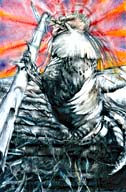|

Comment
on this story
|
|

Artist Leon Wiesener injects humor into the holiday season
by Heather Joyner
The last time I checked out Amsterdam's Stedelijk Museum, Ed Kienholz' The Beanery was still there. A honkin' chunk of American energy and wit circa 1965, its presence in a city that has long embraced outside influences made perfect sense. Sometimes referred to as a "tableaux," The Beanery is a scaled-down beer dive we can actually enter into, chock full of clock-headed patrons. According to art critic Robert Hughes, "What enabled Kienholz to achieve originality in the 1960s was junk, scraps, the offcuts and excreta of America, which he combined first into small hybrid pieces and then into whole rooms and environments. [He] didn't believe in refinement. What he believed in was a mixture of technical know-how, moral anger, and all-American barbaric yawp."
Thirty-five years later, the same might be said of Leon Wiesener. Whether or not found object constructions provide the originality kick they once did, they're alive and well in Wiesener's hands—and amusingly so. In fact, his artist's statement includes an addendum reading, "Please keep in mind, humor rules!" However hollow or pretentious a lot of "jokey" art is, Wiesener's works challenge our thinking while amusing us; the muse that is part of that word has a presence that can be felt in the artist's amusement as well as in our own. The muse may be self-deprecating or self-conscious at times, but we can't deny her daring.
The 17 large pieces on display at the Unitarian Church throughout December, all completed within the past two years, are nothing if not provocative. Entering the gallery space is like walking into someone else's dream and trying to put ourselves in the action—it's a bit strange and intimidating, but if we accept the circumstances, we can run with them.
Before the opening, I heard that Wiesener's art would be considered controversial. Is it because women are pictured holding dismembered legs in his Insektmutter? Or because there are pig ears slathered in iridescent paint? Maybe snakelike foxes with their necks caught in rusty traps are too crude. Or perhaps ostrich eggs with phallic styrofoam protrusions alluding to male genitalia are even cruder. But to focus on the shock value of those elements alone would be to dismiss their often fascinating context. What that context is may not always be clear, but it's rife with possibilities. Wiesener says, "As a maker of these objects, my choices are made within my small sphere of experience. I cannot work without a 'point of view,' and these objects all represent a particular point of view concerning travel, illnesses, pet peeves, current events when they affect my life, and my surroundings in general." Like Kienholz, Wiesener serves up his very individual vision yet allows room for us to make of it what we will.
Two particularly intriguing companion pieces are The Flossing of America and Trash In. Art Out. Both are presented as sets like those used for puppets, and each has a single totemic fish on top—be it the real thing (shellacked) or made of wood. Says Wiesener, "[These] theatrical environments are based on a model used to demonstrate scenery configurations in a small scale and are a standard historically used as models by scenery designers and painters. I have constructed these venues as a way of representing my personal observations in a miniaturized but realistic theatrical space."
Flossing has a joss stick-like fan at front/center, making it a shrine-of-sorts. Placed within is a disturbingly askew ship surrounded by sets of false teeth. In a gaping ring, they speak—no pun intended—of sharks and hunger and fierce consumption. Darkly funny, Flossing could be called a sort of diorama-of-death. The proscenium of Trash In is spanned by mangled train tracks loaded down with all kinds of keys, nuts, and trinkets. Its backdrop, an image of a structure resembling a bomb shelter or survivalist's hangout, suggests that assorted photographs and personal items scattered about are post-apocalyptic. Like remnants of the Holocaust, such items hint at unspeakable tragedy. Trash In seems to contain a despair we know but can't quite identify.
Wiesener's cleverly communicated comic sensibilities are not always so grim. However, his lightness generally balances a somewhat frightening undercurrent. It's almost as if we're looking at visual representations of children's nightmares translated into adult language and symbol. You Are Such A Blockhead, composed of oil paint, pastels and three-dimensional blocks forming a face, is absolutely unique. A sort of modern-day son of William Tell stands in a tub, an arrow piercing his forehead. On a shelf at the base of the canvas are three rubber ducks, lending Blockhead a delightful absurdity.
Other pieces, such as Old Man In Water Behind Fence and Old Man In Water With Wildlife Disguise, feature partially-submerged bodies as well. Besides reveling in the distortion that rendered water produces, Wiesener takes advantage of its connotations. Symbolizing the subconscious, its direct contact with that which is real is transformative. The division between the ordinary and the surreal blurs, and we find ourselves somewhere in between.
Hughes informs us that when Kienholz died in 1994, he was buried in Idaho in his Packard coupe. With a deck of cards and a buck in his breast pocket, a bottle of Chianti on the seat beside him, and the cremains of his beloved dog Smash in the trunk, he left this world as he lived in it: with dramatic flair. Who knows? Wiesener might end up staging an equally remarkable departure some day. I just hope that day does not come for many, many years, as I'm looking forward to seeing what he creates next.

November 30, 2000 * Vol. 10, No. 48
© 2000 Metro Pulse
|